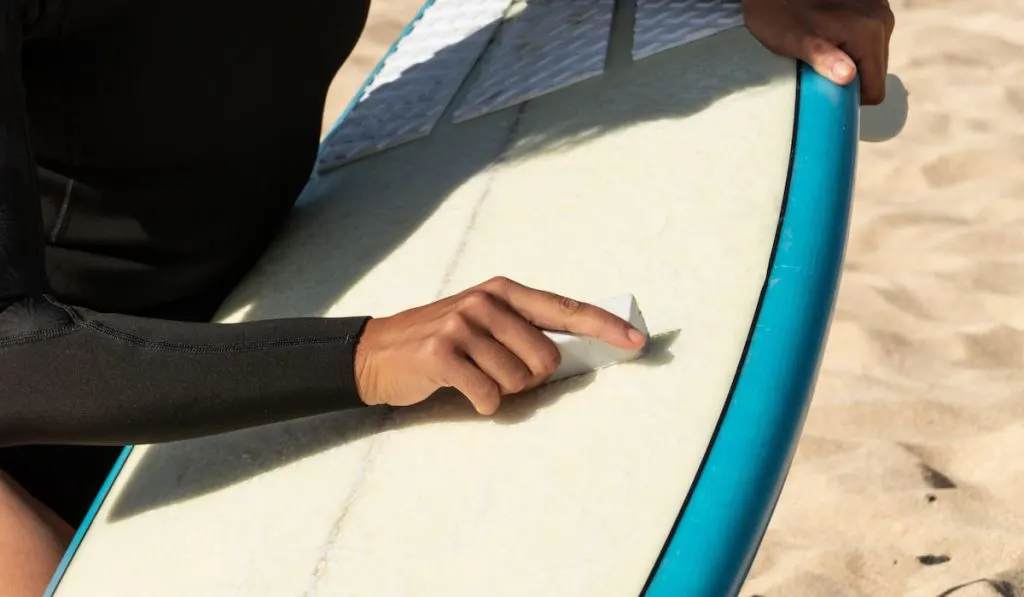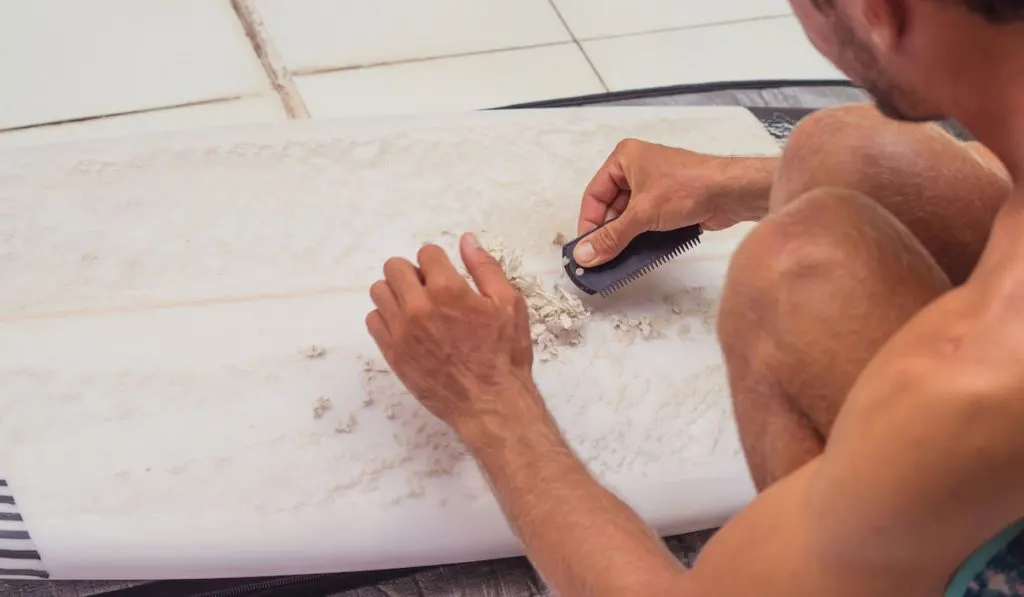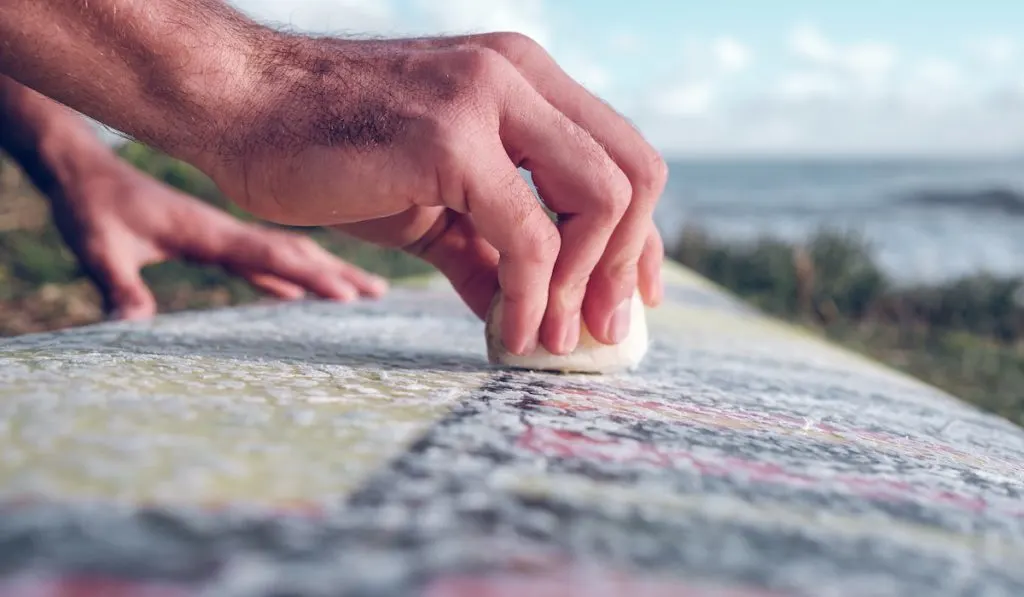Perhaps you’re new to surfing and you’ve heard of ‘surfboard wax.’
What is it? Do surfboards need it? How do you apply it?
Surfboards need wax, it is an essential part of surfboard maintenance for every surfer. There are a wide variety of waxes on the market, each having different properties, so you may need to try multiple options to find out which one is suitable for your needs.
The surfboard wax will help you maintain your grip on the surfboard. It helps you sustain your balance while you ride and try out different surfing tricks.

This article will answer some more of your questions regarding surfboard wax.
What is a surfboard wax?
Surfboard wax is what allows your feet to have a strong grip and traction on your surfboard, thus preventing you from sliding off your board while you catch waves.
Typically, surfboard wax is made up of paraffin, beeswax, and other hard waxes. Sometimes, a petroleum jelly is added to create a soft consistency. To create a variety of scents, other substances are added.
Aside from surfing, wax is also used for an increased grip when paddling a surf kayak or dragon boat.
Two Layers of Wax
There exist many types of surfboard waxes that you can use. While their names are all funny and appealing, you should focus on their quality and if your surfing environment matches the classification of the wax.
Aside from that, you should know that there are two layers of wax that you need to put on your board: the base coat and the top coat.
First, we’ll talk about the base coat. The base coat is considered the first layer of wax that you’re going to put on your surfboard. Typically, it should contain harder wax, which makes it suitable for warm water, or those surfing spots in tropical climates.
Basically, the base coat will support your top coat. Once you apply your base coat, you’re also creating mini bumps of wax which will help you sustain your balance while you surf. The base coat usually lasts longer than the top coat, but it is harder to apply. That’s why it is important for you to know how to properly apply it.
Meanwhile, the top coat is used to make your base coat stronger and more pronounced. Unlike the base coat, this wax is applied gently in a circular motion. Make sure that you don’t apply too much wax, or else it’ll be harder to surf.

Two Types of Wax
There are two types of wax that I am going to briefly discuss. Knowing these waxes can help you decide which wax you’re going to use on your next surfing escapade.
Traditional
This type of wax is more popular. It is used for both base coats and top coats. When using traditional wax, you will need to wait for a few minutes before your surfboard gets sticky enough to create traction.
Sticky
However, if you’re not sure if your board is waxed sufficiently with the traditional wax, you can use the sticky one instead. Unlike the traditional wax, the sticky wax should only be applied to the area where you will place your feet while you surf. However, applying too much will give you a very sticky board which will ruin your surfing experience.
How do you apply surfboard wax?
Now, we’ve come to the application of wax. Before putting wax on your surfboard, make sure that you are in a place with shade so that your wax won’t melt easily.
Follow these steps to apply wax to your surfboard:
- Clean your surfboard. It is necessary to remove old wax because it’ll only make your new wax awful and messy.
- Apply your base coat until you get small bumps.
- Gently apply your top coat.
Keep in mind that you only need to wax the area where you’re going to place your feet.
Applying wax on unnecessary areas will only add additional weight to your surfboard.
You don’t need to apply wax every surfing session. You only have to give it a quick comb using your surf comb, and add a new layer of top coat. It is recommended to remove and reapply all your wax only every two months.
Additionally, if you’re having a hard time holding your surfboard riding, you may add a little bit of wax on the edges of the surfboard. But be sure not to put wax on your board’s underside. It isn’t necessary for grip and if you transport your board on your car, when the wax melts it will be very messy.
Keep in mind that applying too much wax will make your surfboard slippery, defeating the purpose of the wax.
How do you remove surfboard wax?

There are many ways to remove wax from your surfboard but here are the three most common.
- Remove it by covering your board with sand. Leave it out for a few minutes while the sand loosens the wax on your board. After that, wipe your board with the sand that covered it. That’s it.
- Use a heat gun. Lay your board on grass, or cardboard, and work with a heat gun to melt the wax. Once it melts, use gloves and a rag to wipe off the melted wax. It’s hot, so be careful not to burn your hands. This method works great if you are at home and sand is not available.
- Use a wax comb. Run your wax comb on the waxed areas of your board, wiping away excess wax. Repeat until it’s clean and glossy.
Whichever method you use, make sure that your board is very clean before applying a new coat of wax. Putting new wax on top of old wax can make for awful traction and balance on your next ride.
Total removal of your wax is only done when you feel that you’re losing traction with your board. The effectiveness of the wax depends on your area’s climate and temperature.
Why is wax temperature important?

You should know that surfboard waxes vary depending on where they will be used. So, you shouldn’t use a wax that is intended for cold water when surfing under the heat of the sun in Hawaii.
Using a cold-water surfboard wax in a warm climate will only melt your wax. Similarly, using surfboard wax designed for warm water in a cold water environment can cause the wax to get too cold and possibly lose its ability to give you traction.
The good thing is, most wax brands provide a variety of waxes for different temperatures so you won’t need to switch brands if you ever decide to surf in various environments.
Surfboard wax is an important factor to make your surfing experience a remarkable one, so don’t hesitate to invest in a high-quality wax that, of course, is suitable for your chosen surfing environment.
And there you have it. I hope that this article was able to answer your questions. Before you go and ride some waves, feel free to share this information with your family, friends, or your surfing buddies!
References:
- https://www.degree33surfboards.com/blogs/gettin-pitted/14071053-what-is-surf-wax-used-for-and-how-do-you-apply-it.
- https://www.surfnation.com.au/blogs/news/ultimate-guide-to-surf-wax
- https://www.wetsuitoutlet.co.uk/blog/why-do-you-need-to-wax-your-surfboard-df2dzwd.html
- https://en.wikipedia.org/wiki/Surfboard_wax
- https://www.surfertoday.com/surfing/how-to-wax-a-surfboard
